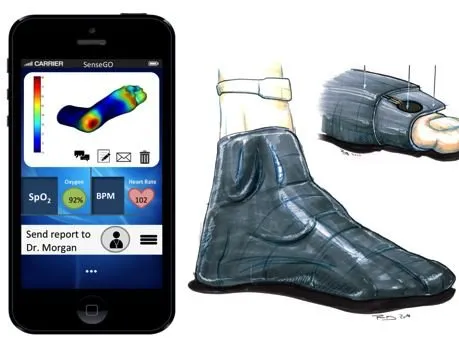Among some of the possible symptoms of diabetes are anatomical deformations, increased blood pressure and alterations in blood irrigation, which frequently causes nerve damage to legs and feet, even sometimes also in hands and arms.
The most severe consequence of this pathology is the amputation of a member of the lower or higher limbs, which leaves some diabetics with disabilities.
"We face a very significant medical problem, which affects the lives of millions of people. We believe there must be a way to avoid the worsening of these pathologies," said Danny Bavli, the leading engineer of the project.
Bavli associated with Sagi Frishman and Dr. David Morgenstern, an outstanding orthopedist surgeon from the Hadssah Medical Center, who together with members of the Biological Design Group of the Hebrew University created Sensogo.
How does it work?
Sensongo feels pressure changes derived from incorrect postures and anatomical deformations through electrical signals that are referred to the application of the phone.If necessary, the smartphone informs patients of possible risks.
"We are facing a classic mobile health approach. By giving patients and their families the tools they need to prevent ulcer developments, we can drastically reduce medical costs related to diabetes," said Professor Yakov Nahmias, director of the design programBiological of the University.
This wearable would cause a great impact not only to improve the health of patients, but also on the costs of the health systems of the countries, since as a prevention medical equipment recommends their patients to perform periodic reviews to detect increases inthe pressure and ulcerations.Unfortunately, ulcers can only be diagnosed once they have appeared, which implies that the patient will require a cure period, and this in turn has an impact on health costs.
Smart Sox: The North American case
In turn, the Department of Surgery of the University of Arizona del Sur, in association with the Hamad Medical Corporation - sustained by the National Research Fund of Qatar - generated Smart Sox.
As with Sensogo, socks will be used by people with diabetes, who are at risk of forming feet ulcers that can lead to amputation and death.
To develop them, scientists used “intelligent” textiles, composed of optical fiber and sensors that monitor the temperature, pressure and angles of feet joints.

People with diabetes often lose the feeling of pain and are not aware of developing ulcers in their feet and, in this way, health professionals can be alerted.
“What we can do now with these intelligent socks, potentially, is to identify a conflictive point and perhaps identify movements that are problematic and stress.That could give us an early warning sign, ”said Surgery Professor David Armstrong, from the Medical Center of the University of Arizona.


